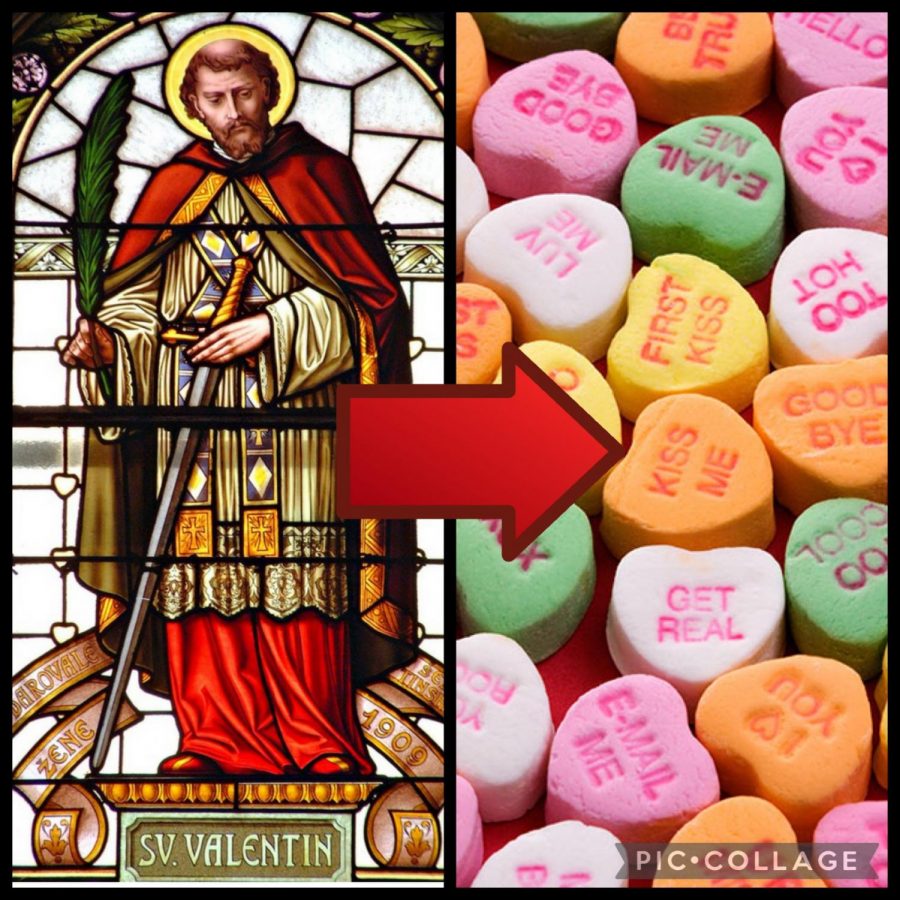More Than Just A Clichéd Holiday
Valentine’s Day, while painted as an excuse to buy endless amounts of candies and flowers, has an intriguing history dating back thousands of years.
photo courtesy of Pinterest and Britannica.com
Valentine’s Day started with religious origins but has become a commercialized holiday.
February 12, 2021
Valentine’s Day, to many, is perceived to be a day exclusively for celebrating the love shared between couples and for single people to enviously await a partner. The holiday that generates fortunes for chocolate companies makes February a month either anticipated or despised, depending on a person’s romantic status.
However, the seemingly clichéd holiday is based on a history deeper than what many believe. While the approach of February 14th does drastically improve their sales, candy companies did not create Valentine’s Day. Instead, the festival of love has rich origins and thousands of years of history that have made it what it is today.
270 A.D. is presumed to have been the first year with a Valentine’s Day, as it marks the death of St. Valentine, whom the holiday is named after. The multiple legends and people that are the supposed St. Valentine truly represent the pure meaning behind Valentine’s Day.
As a Catholic priest in Rome, St. Valentine decided that Emperor Claudius’s II law that stated that young men could no longer marry, as it was a distraction from their work as soldiers, was unjust. In response, St. Valentine performed secretive marriages for young soldiers and their soon-to-be wives. Unfortunately, his hidden practices were discovered by the emperor, and St. Valentine was convicted, leading to his execution.
Numerous theories exist regarding St. Valentine. Another legend tells a different story but still represents the perseverance of love. St. Valentine was jailed because he helped the Christians escape Roman prisons, and he supposedly fell in love with a woman who visited him regularly. It is believed that the woman was St. Valentine’s jailer’s daughter. Before his time of death in the jail, a letter was written to the woman with the closing, From your Valentine, which historians believe to be the origin of the traditional love note sign-off.
Even though very little is known about the validity of St. Valentine’s legacy, his stories demonstrate what many would consider the true spirit of Valentine’s Day: The endurance of love and how it drives people to do whatever it takes to hold onto it are illustrated perfectly in his tales.
The date February 14th also has its own little history. In the ancient Roman calendar, a holiday quite similar to the current Valentine’s Day was already honored in the middle of February. This holiday was called Lupercalia. It recognized fertility and the pairing of couples through a man picking a woman’s name out of a jar. However, this holiday was much more gruesome, as it included animal sacrifices and the striking of women to gain fertility.
On a brighter note, though, ancient Greece memorialized the wedding of the god Zeus and the goddess Hera halfway through winter around the same time as modern Valentine’s Day.
Due to these two ancient celebrations, as well as the anniversary of St. Valentine’s death, Valentine’s Day was officially on February 14th.
As the centuries went on, February 14th’s speciality evolved into what most people today know Valentine’s Day to be: the overdone, lovey-dovey holiday that most single individuals loathe.
It is sometimes mentioned as the “Hallmark Holiday,” and for good reason. The annual amount of money spent for the holiday is over $18.2 billion, which includes the jewelry, candy, flowers, and whatever else one decides to buy for their loved one.
So, when did the martyred St. Valentine’s holiday turn into a day for writing mini love letters to others and for spending hundreds of dollars on endless candies? Well, in 1849, the first American valentine was published by Esther Howland of Worcester, Massachusetts. Then, the Hallmark Company published their first Valentine’s Day cards in 1913 and began mass-producing them in 1916.
The tradition of candy buying started in 1861 with the creation of the decorated heart-shaped boxes filled with chocolate. Richard Cadbury would adorn the boxes with hand-drawn pictures of his family and scenes of the mountainous Alpine landscape. It upped his sales and obviously grew in popularity over the years.
Soon after, in 1866, Daniel Chase invented a food-dye letter pressing machine that his brother, Oliver Chase, would make popular. The Sweethearts Candy Hearts emerged from this innovation, and to this day, are the best-selling Valentine’s Day treat. Lastly, Hershey Kisses started being mass produced in 1907. The candies are usually wrapped in red foil to commemorate the ideals of Valentine’s Day.
Valentine’s Day has thousands of years of interesting and compelling history that most celebrators don’t necessarily know about. Usually distinguished as a useless holiday only utilized for large corporations to gain even more money, Valentine’s Day has a great more to offer. Since it has become a celebration that only focuses on people in relationships, many have shunned the holiday.
Nevertheless, its rich story could become a turning point in its quest to acquire a greater acceptance from society. Looking into the mysterious origination of the holiday instead of relying solely on the commercialized modern version can lead to a new perspective regarding Valentine’s Day and all it has to offer.













